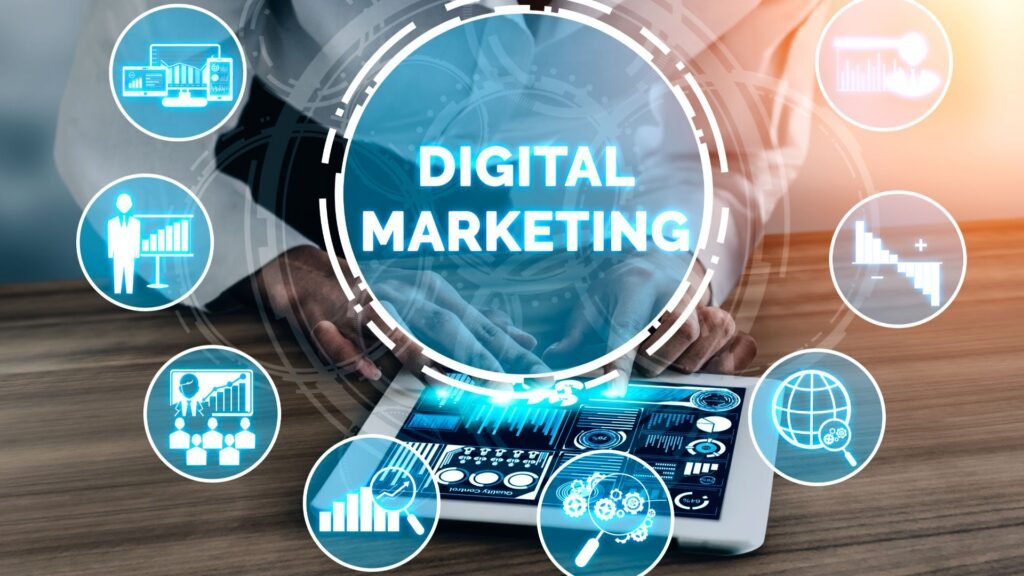
In the dynamic world of modern business, the efficacy of marketing strategies holds immense sway over the success of any brand or enterprise. The emergence of digital technologies has catalyzed a profound evolution in the marketing landscape, reshaping traditional paradigms and demanding innovative approaches. While still relevant, conventional marketing techniques are now complemented and often surpassed by digital marketing strategies. In this blog post, “Select three ways in which digital marketing differs from conventional marketing techniques” we will delve into three fundamental ways digital marketing differs from conventional marketing and how businesses can leverage these differences to their advantage.
Overview of Digital Marketing

Digital marketing encompasses various strategies and techniques for promoting products or services through digital channels. In today’s interconnected world, where consumers increasingly rely on digital devices and platforms, digital marketing has become essential to any comprehensive marketing strategy.
At its core, digital marketing leverages various online platforms to reach and engage with target audiences. These channels include but are not limited to:
- Search Engine Optimization (SEO): SEO entails refining a website’s content and structure to enhance its visibility in search engine results pages (SERPs). Businesses can boost organic traffic and attract qualified leads by targeting pertinent keywords and improving website performance.
- Social Media Marketing: Utilizing platforms like Facebook, Instagram, Twitter, and LinkedIn, social media marketing empowers businesses to engage with audiences and bolster brand awareness. Through content creation, targeted advertisements, and follower interactions, brands foster relationships and drive conversions.
- Content Marketing: Focused on delivering valuable, consistent content, content marketing aims to attract and retain a defined audience. Businesses establish authority through mediums like blogs, articles, videos, and infographics and address consumer needs and challenges.
- Email Marketing: Despite advancements, email remains a potent channel for lead nurturing and customer retention. Personalized content, promotions, and updates delivered directly to subscribers’ inboxes drive engagement and conversions.
- Pay-Per-Click (PPC) Advertising: PPC advertising enables businesses to display ads on search engines and platforms, paying solely for user clicks. This cost-efficient model targets specific keywords, demographics, and user behaviors, driving targeted traffic to websites and landing pages.
- Digital Analytics and Reporting: Essential to digital marketing, analytics tools offer insights into campaign performance. By analyzing metrics like website traffic, conversion rates, and ROI, businesses make data-driven decisions to optimize strategies and enhance results.
Digital marketing offers a versatile and dynamic approach to reaching and engaging consumers in today’s digital age. By leveraging the power of online channels and data-driven insights, businesses can create impactful marketing campaigns that drive results and foster long-term success.
Overview of Conventional Marketing

Conventional marketing refers to the traditional methods businesses use to promote their products or services before the advent of digital technologies. These techniques have been honed over decades and have played a vital role in shaping the marketing landscape. Here’s an overview of some critical conventional marketing techniques:
- Print Advertising: Print advertising includes newspaper ads, magazine ads, flyers, brochures, and other printed materials. These ads are distributed through various publications to reach a broad audience.
- Television Commercials: Television commercials are short advertisements broadcasted during commercial breaks on television networks. They aim to capture viewers’ attention and promote products or services through compelling visuals and messages.
- Radio Advertising: Radio advertising involves airing audio commercials on radio stations. These ads typically target specific demographics based on the radio station’s audience demographics and programming.
- Direct Mail Marketing: Direct mail marketing involves sending physical promotional materials, such as postcards, catalogs, or letters, directly to consumers’ mailboxes. This technique allows businesses to target specific geographic areas or demographics.
- Telemarketing: Telemarketing involves making unsolicited phone calls to potential customers to promote products or services. While effectively reaching many people quickly, telemarketing has faced criticism for being intrusive.
- Outdoor Advertising: Outdoor advertising includes billboards, posters, and other signage in high-traffic areas such as highways, bus stops, and city streets. These ads aim to capture passersby’s attention and create brand awareness.
- Event Marketing: Event marketing involves sponsoring or participating in trade shows, conferences, and festivals to promote products or services. This technique allows businesses to interact more engagingly with potential customers directly.
Conventional marketing techniques have been foundational in the field and have proven effective in reaching broad audiences. However, with the rise of digital technologies, businesses increasingly incorporate digital marketing strategies to complement or replace conventional techniques, allowing for more targeted, interactive, and measurable marketing efforts.
The Evolution of Marketing: Digital vs. Conventional

In the ever-changing marketing landscape, the evolution from conventional to digital methods has revolutionized how businesses reach and engage with their audiences. Traditional marketing techniques, such as print advertisements, TV commercials, and billboards, have long been the staple of marketing efforts. However, the advent of digital technologies has ushered in a new era of marketing strategies that offer unparalleled precision, interactivity, and measurability.
- Digital Marketing: Digital marketing, on the other hand, has transformed how businesses connect with consumers. With the rise of the internet, social media, and mobile technologies, digital marketing offers various channels and tools for reaching targeted audiences with tailored messaging. Through data analytics, artificial intelligence, and machine learning algorithms, digital marketers can gather valuable insights into consumer behavior and preferences. This wealth of data enables marketers to segment audiences accurately and deliver personalized content that resonates with individual interests and needs.
- Conventional Marketing: Conventional marketing techniques have been the cornerstone of advertising for decades. Print ads in newspapers and magazines and TV and radio commercials were once the primary means of reaching mass audiences. These methods relied heavily on broad demographic targeting and mass distribution channels, often with limited opportunities for direct consumer interaction. While conventional marketing was effective in its own right, its reach was constrained by geographical limitations and could not deliver personalized experiences.
The Key Differences
The key differences between digital and conventional marketing lie in targeting precision, engagement, and measurability. Digital marketing allows for highly targeted campaigns that reach specific audience segments with personalized messages, leading to higher engagement and conversion rates. Furthermore, digital marketing offers unparalleled measurability, with tools and analytics platforms that provide real-time insights into campaign performance and ROI.
Select Three Ways In Which Digital Marketing Differs From Conventional Marketing Techniques
Here are three fundamental ways in which digital marketing differs from conventional marketing techniques:
Targeting and Personalization

Digital marketing allows for exact targeting and personalized messaging compared to conventional marketing techniques. With digital platforms, marketers can leverage data analytics and user insights to segment their audience based on demographics, interests, behaviors, and more.
This targeted approach ensures that marketing messages are delivered to the most relevant audience segments, increasing the likelihood of engagement and conversion. In contrast, conventional marketing often relies on broad demographic targeting, resulting in messages that may not resonate with specific audience subsets.
Engagement and Interactivity

Digital marketing offers more significant engagement and interactivity opportunities than conventional marketing methods. Brands can foster two-way communication with their audience through social media platforms, interactive websites, mobile apps, and other digital channels. Interactive content such as polls, quizzes, live chats, and immersive experiences capture attention and encourage consumers’ active participation.
This level of engagement allows brands to build meaningful relationships with their audience, gather feedback, and address customer inquiries in real time, enhancing the overall customer experience. In contrast, conventional marketing channels like print ads and TV commercials often offer limited opportunities for direct engagement and interaction.
Measurability and Analytics

Digital marketing provides robust measurability and analytics capabilities far more advanced than conventional marketing techniques. With digital tools such as website analytics, email marketing platforms, and social media insights, marketers can track real-time metrics, including website traffic, conversion rates, click-through rates, and customer engagement.
This data-driven approach allows marketers to accurately assess their campaigns’ effectiveness, identify improvement areas, and optimize their strategies for better results. In contrast, conventional marketing methods often require a different level of measurability and accountability, making it challenging to track the impact of marketing efforts and calculate ROI accurately.
Advantages and Disadvantages of Digital Marketing Techniques

Digital marketing techniques offer many advantages but face their fair share of challenges. Understanding the pros and cons is essential for businesses navigating the digital landscape effectively.
Advantages
- Global Reach: Digital marketing enables businesses to reach an international audience without the constraints of geographical boundaries. With the internet connecting people worldwide, companies can quickly expand their reach and tap into new markets.
- Cost-Effectiveness: Compared to traditional marketing methods like print advertising or TV commercials, digital marketing is often more cost-effective. With tools like social media, email marketing, and content creation platforms, businesses can reach their target audience at a fraction of the cost.
- Targeted Advertising: Digital marketing allows for precise targeting of specific demographics, interests, and behaviors.
- Measurable Results: Unlike traditional marketing, digital marketing offers tools that provide real-time insights into campaign performance. Businesses can track key metrics and optimize their strategies for better results.
Disadvantages
- Digital Noise: Cutting through the clutter requires innovative strategies and compelling content that captures the audience’s attention.
- Technical Challenges: Digital marketing often requires technical expertise. Keeping up with ever-changing algorithms and technology trends can be daunting for businesses without dedicated resources or expertise.
- Privacy Concerns: Digital marketing has raised concerns about consumer privacy and data security. Businesses must navigate regulations to ensure compliance and build trust with their audience.
- Ad Blocking: As more consumers opt to block ads, businesses must find alternative ways to effectively engage with their audience.
Digital marketing techniques offer numerous advantages such as global reach, cost-effectiveness, targeted advertising, and measurable results, businesses must also be mindful of challenges such as digital noise, technical complexity, privacy concerns, and ad blocking. By leveraging the strengths of digital marketing while mitigating its drawbacks, businesses can create successful marketing strategies.
Advantages and Disadvantages of Conventional Marketing Techniques
Conventional marketing techniques have long been the cornerstone of traditional advertising and promotional strategies. While they have been effective for many years, they have their own pros and cons.
Advantages
- Broad Reach: Conventional marketing techniques, such as television commercials, print ads, and billboards, have the potential to reach a broad audience. This mass exposure can be particularly beneficial for brands looking to build awareness on a large scale.
- Tangible Presence: Print materials like brochures, flyers, and posters provide a tangible presence that can leave a lasting impression on consumers. Physical marketing materials can be distributed strategically in high-traffic areas, allowing brands to engage with potential customers in real-world environments.
- Established Credibility: Traditional media outlets, such as newspapers, magazines, and television networks, often have established credibility and authority in consumers’ eyes. By advertising through these channels, brands can benefit from association with reputable sources, enhancing their credibility and trustworthiness.
Disadvantages
- Limited Targeting: Conventional marketing techniques typically need more precision targeting capabilities of digital marketing. With traditional methods, reaching specific audience segments based on demographics, interests, or behavior can be challenging, resulting in less efficient use of marketing resources.
- High Cost: Advertising through traditional channels can be expensive. Costs associated with printing, distribution, and media placement make it difficult for smaller brands to compete with larger competitors.
- Difficulty in Measurement: Unlike digital marketing, which offers robust analytics and tracking capabilities, conventional marketing techniques cannot often accurately measure campaigns’ effectiveness. Attributing sales or conversions directly to traditional advertising efforts can be challenging, making it difficult to assess ROI and optimize marketing strategies accordingly.
Conventional marketing techniques have advantages in terms of broad reach, tangible presence, and established credibility, they also have limitations such as limited targeting, high cost, and difficulty in measurement. As the marketing landscape evolves, businesses must carefully consider their marketing mix and leverage traditional and digital strategies to effectively achieve their goals.
Future Trends in Digital Marketing
Future trends in digital marketing include increased use of AI and Machine Learning for personalized content, augmented reality for immersive brand experiences, and voice search optimization. Social commerce will continue growing, directly integrating shopping into social media platforms. Video content, particularly short-form videos and live streaming will dominate as preferred mediums. Data privacy and ethics will become more prominent, necessitating transparent and responsible data usage. Lastly, the rise of blockchain technology will enhance transparency and security in digital advertising and transactions. Adapting these trends will be crucial for marketers to stay competitive in the digital landscape.
Future Trends in Conventional Marketing
Future trends in conventional marketing will likely focus on integrating digital technologies for enhanced targeting and personalization. Traditional methods will leverage data analytics to reach specific audience segments effectively. Additionally, experiential marketing approaches, such as pop-up events and immersive brand activations, will continue to gain prominence, offering consumers unique offline experiences. Moreover, sustainability and social responsibility will become increasingly important, driving brands to adopt eco-friendly practices and align with causes that resonate with consumers. Overall, conventional marketing will evolve to blend traditional strategies with innovative approaches to meet the changing needs of consumers.
FAQs
Q1: How does digital marketing differ from conventional marketing?
A1: Digital marketing differs from conventional marketing primarily in its approach to targeting and personalization, engagement and interactivity, and measurability and analytics. Digital marketing leverages data analytics and advanced technologies to target specific audience segments, engage consumers through interactive channels, and measure campaign performance more accurately.
Q2: What are the key advantages of digital marketing over conventional marketing?
A2: Some key advantages of digital marketing include targeting audiences with precision, fostering engagement and interactivity through digital channels, and measuring campaign effectiveness in real-time. Digital marketing also offers opportunities for personalization, instant feedback, and cost-effective advertising compared to traditional methods.
Q3: What are some examples of engagement and interactivity in digital marketing?
A3: Examples of engagement and interactivity in digital marketing include social media campaigns, interactive website content, mobile apps, live streaming events, and immersive experiences such as virtual reality (VR) or augmented reality (AR) marketing. These techniques encourage active participation from consumers, fostering deeper connections with brands and driving customer engagement.
Conclusion
In conclusion, digital marketing differs from conventional marketing techniques in several significant ways, including targeting and personalization, engagement and interactivity, and measurability and analytics. By leveraging the unique capabilities of digital channels, businesses can reach their target audience more effectively, foster meaningful relationships, and achieve measurable results that drive business growth. As the digital landscape continues to evolve, staying abreast of emerging trends and technologies will be essential for marketers looking to stay ahead of the curve and maximize their marketing ROI.








No Comments